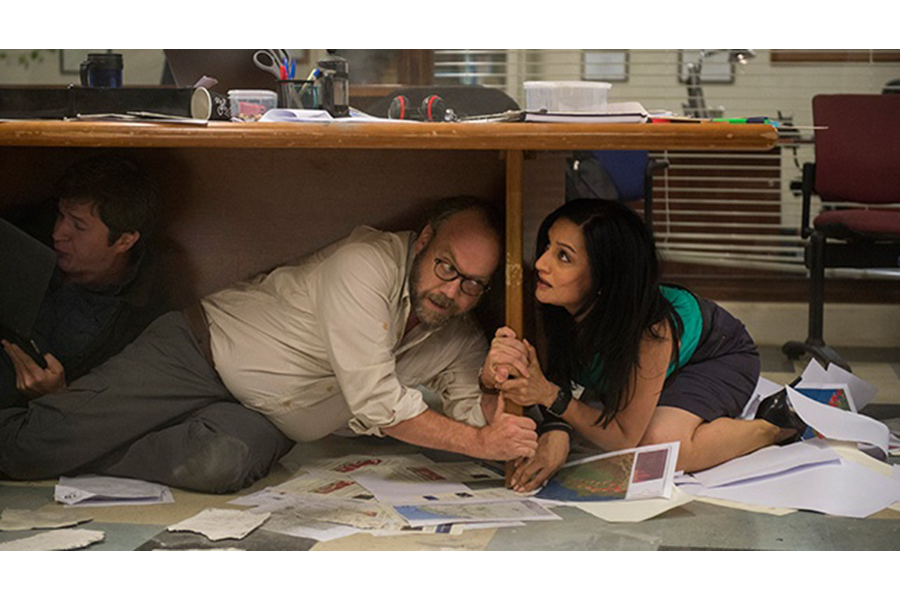Scientists say 'San Andreas' is not accurate: Will moviegoers care?
Loading...
| Los Angeles
The coming release of Dwayne Johnson’s movie “San Andreas” this weekend is reopening the debate about how much creative license Hollywood should take in disaster movies.
In the film, a colossal earthquake rips apart California’s San Andreas Fault setting off a tsunami and sending devastating reverberations clear across the United States.
“Here’s the crazy thing about it,” Mr. Johnson told Jimmy Fallon during an appearance on "The Tonight Show" last Thursday. “We had the world’s top seismologist and and earthquake scientist pore over the script ... so by the time they walked away the said, ‘Everything you guys shoot in the movie could actually happen.’ We pray that it doesn't happen but it can."
Not so, says the US Geological Survey.
“Hollywood exaggerates for cinematic effect, we all know this,” says USGS spokesman Justin Pressfield.
Warner Bros. Entertainment did not return requests for comment on the validity of the movie premise or identify the seismologist consulting on the film.
Mr. Pressfield takes scientific issue with the film depicting the earth splitting and says that the San Andreas would never create a tsunami because of its fault type.
Still, “the movie has some excellent scenes that show characters taking proper safety measures,” Pressfield adds. “It is important to remember that the movie is not a documentary and doesn’t reflect reality. Still, it is fantastic to see Dwayne Johnson and Paul Giamatti yell ‘Drop, cover, and hold on!’ I couldn’t have said it better myself.’ ”
But for Hezekiah Lewis, a film professor at Villanova University near Philadelphia who grew up living on the San Andreas Fault in San Bernardino, realistic safety protocols do not make up for what he sees as irresponsible scientific discrepancies.
“I think it’s dangerous to mislead the audience to think that buildings shake and explode like that, even though it’s fiction and everyone knows,” says Professor Lewis. “I think the filmmakers should go out of their way to say what can and can’t happen, and filmgoers should know as well.”
For many moviegoers, however, a trip to the theater is a break from reality – especially going into the summer season when fantastic action films dominate marquees. NASA identified 168 scientific inaccuracies in Touchstone Pictures' 1998 film "Armageddon." That didn't deter movie goers from dropping $200 million at the box office. And Jan De Bont's 1996 blockbuster "Twister" grossed nearly $250 million in box office sales despite numerous inaccuracies, including a live cow being flung out of the epicenter of a cyclone.
“Whenever I hear a question about whether the portrayal of this or that is inaccurate to the actual world, I say, ‘that’s why they call them movies,’ ” says Bob Thompson, founder of the Bleier Center for Television and Popular Culture at Syracuse University. “ 'Richard the Third' is terrible English history but a really good Shakespeare play.”
Professor Thompson thinks playing it right up the middle between reality and fantasy is the way to go.
“You don’t have to have the seal of approval from the USGS, but it can’t be so ridiculous that it’s not plausible,” he says. “Audiences will turn on something if it seems too fake, but they’re not going to movies to learn truths about how the crust of the earth operates.”
For those looking for some scientific accuracy to put the film into context, here are some apropos factoids from USGS:
- The San Andreas Fault is not long and deep enough to have a magnitude 9 or larger quake as depicted in the movie. The largest historical earthquake on the San Andreas was the 1906 magnitude 7.9 earthquake. It is plausible that a 8.3 quake could hit the San Andreas, but even that would not be “felt on the East Coast” as Paul Giamatti’s character claims in the film.
- Faults do not split apart during earthquakes as shown in the movie. The ground on the two sides of the fault slide past each other; they do not pull apart. Narrow crevices may form due to bends in the fault or in regions with very strong shaking.
- There are simple steps residents living near active fault lines can take to prepare for an earthquake. Visit www.earthquakecountry.org/sevensteps to learn more.
[Editor's note: This story has been updated to clarify a quote that was incorrectly attributed to USGS spokesman Justin Pressfield.]







